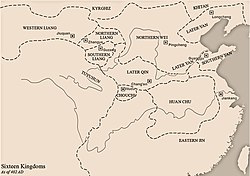Later Qin
Appearance
Later Qin ([後秦] Error: {{Lang}}: invalid parameter: |nocats= (help)) [秦] Error: {{Lang}}: invalid parameter: |nocats= (help) | |||||||||||||||
|---|---|---|---|---|---|---|---|---|---|---|---|---|---|---|---|
| 384–417 | |||||||||||||||
 Later Qin in 402 AD | |||||||||||||||
| Capital | Chang'an | ||||||||||||||
| Government | Monarchy | ||||||||||||||
| Emperor | |||||||||||||||
• 384-393 | Yao Chang | ||||||||||||||
• 394-416 | Yao Xing | ||||||||||||||
• 416-417 | Yao Hong | ||||||||||||||
| History | |||||||||||||||
• Established | 384 | ||||||||||||||
• Yao Chang's claim of imperial title | 386 | ||||||||||||||
• Liu Bobo's rebellion | 407 | ||||||||||||||
• Disestablished | 20 September 417[1][2] 417 | ||||||||||||||
| |||||||||||||||
The Later Qin (simplified Chinese: 后秦; traditional Chinese: 後秦; pinyin: Hòuqín; 384-417), also known as Yao Qin (姚秦), was a state of Qiang ethnicity of the Sixteen Kingdoms during the Jin dynasty (265-420) in China.[3] The Later Qin is entirely distinct from the Qin dynasty, the Former Qin and the Western Qin.
Its second ruler, Yao Xing, supported the propagation of Buddhism by the Madhyamakin monk Kumārajīva.
All rulers of the Later Qin declared themselves emperors, but for a substantial part of Yao Xing's reign, he used the title Tian Wang.
Rulers of the Later Qin
| Temple names | Posthumous names | Family names and given name | Durations of reigns | Era names and their according durations |
|---|---|---|---|---|
| Chinese convention: use family and given names | ||||
| Taizu (太祖 Tàizǔ) | Wuzhao (武昭 Wǔzhāo) | Yáo Cháng (姚萇) | 384-393 | Baique (白雀 Báiquè) 384-386 Jianchu (建初 Jiànchū) 386-393 |
| Gaozu (高祖 Gāozǔ) | Wenhuan (文桓 Wénhuán) | Yáo Xīng (姚興) | 394-416 | Huangchu (皇初 Huángchū) 394-399 Hongshi (弘始 Hóngshǐ) 399-416 |
| Did not exist | Hòuzhǔ (後主 Hòuzhǔ) | Yáo Hóng (姚泓) | 416-417 | Yonghe (永和 Yǒnghé) 416-417 |
Rulers family tree
| Later Qin rulers family tree | |||||||||||||||||||||||||||||||||||||||||||||||||||||||||||||||||||||||||||||||||||||||||||||||||||||||||||||||||||||||||||||||||||||||||||||||||||||||||
|---|---|---|---|---|---|---|---|---|---|---|---|---|---|---|---|---|---|---|---|---|---|---|---|---|---|---|---|---|---|---|---|---|---|---|---|---|---|---|---|---|---|---|---|---|---|---|---|---|---|---|---|---|---|---|---|---|---|---|---|---|---|---|---|---|---|---|---|---|---|---|---|---|---|---|---|---|---|---|---|---|---|---|---|---|---|---|---|---|---|---|---|---|---|---|---|---|---|---|---|---|---|---|---|---|---|---|---|---|---|---|---|---|---|---|---|---|---|---|---|---|---|---|---|---|---|---|---|---|---|---|---|---|---|---|---|---|---|---|---|---|---|---|---|---|---|---|---|---|---|---|---|---|---|
| |||||||||||||||||||||||||||||||||||||||||||||||||||||||||||||||||||||||||||||||||||||||||||||||||||||||||||||||||||||||||||||||||||||||||||||||||||||||||
See also
- Ethnic groups in Chinese history
- Five Barbarians
- Chinese Buddhism
- Emperor Wu of Liu Song
- Helian Bobo
Notes and references
- ^ http://www.sinica.edu.tw/ftms-bin/kiwi1/luso.sh?lstype=2&dyna=%AAF%AE%CA&king=%A6w%AB%D2&reign=%B8q%BA%B3&yy=13&ycanzi=&mm=8&dd=&dcanzi=%AC%D1%A5%E8
- ^ Zizhi Tongjian, vol. 118.
- ^ Grousset, Rene (1970). The Empire of the Steppes. Rutgers University Press. p. 59. ISBN 0-8135-1304-9.
